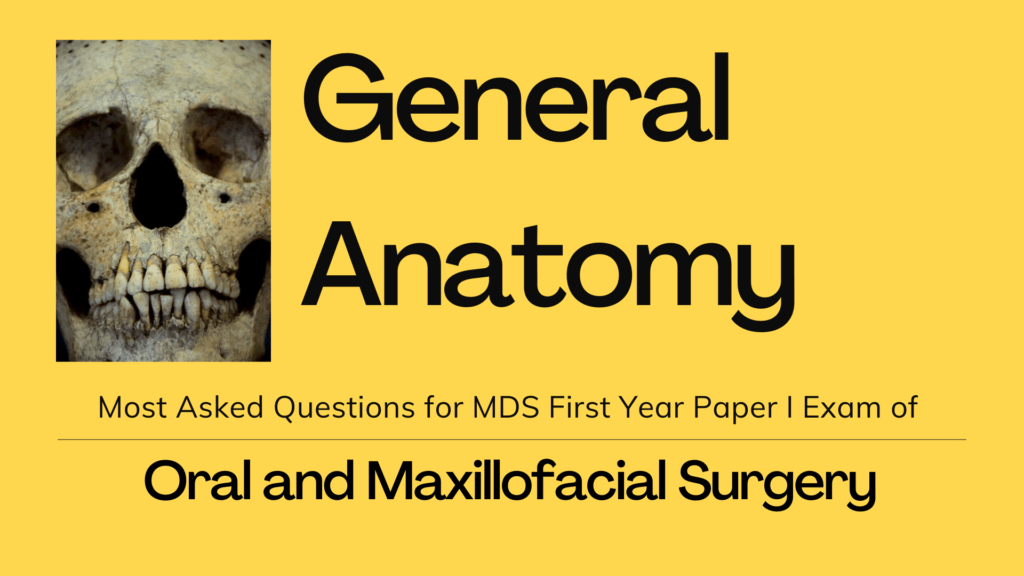Hi there, With the help of Dr. Shreya Shukla and Dr. Viplove Ukey, I’m pleased to give you this exhaustive list of the most important questions asked in the MDS First Year Exam of Oral and Maxillofacial Surgery, specifically General Anatomy in the past years from all over the universities in India. Remember, this is not a complete list and we shall keep on adding new questions as soon as we find them. You can comment below questions/topics which your university has asked if it is missing and we shall add that too. Do check the DCI syllabus and prepare accordingly.
MDS First Year General Anatomy Questions
- Surgical Anatomy of TMJ and write a note on various approaches to TMJ & its merits & demerits & internal derangement
- Describe in detail the development of the face, paranasal sinuses, and associated structure and add a note on facial anomalies
- Describe the extra-cranial course of mandibular nerve and its anatomical relationship
- Discuss the arterial supply to the head and neck region. Enumerate applied aspects with vascular ligation
- Discuss facial embryology and its relevance with cleft lip and palate conditions
- Describe in detail the surgical anatomy of Tongue and write in detail the applied anatomy
- Describe in detail about surgical anatomy of submandibular region and write briefly on applied anatomy of submandibular space
- Describe in detail the surgical anatomy of facial nerve
- Describe surgical anatomy of maxillary sinus and explain the management of chronic oro antral fistula
- Describe in detail surgical anatomy of muscles of facial expression and mention their nerve and blood supply along with specific actions
- Triangles of neck
- Describe osteology of orbit and discuss important anatomical neurovascular structures associated with it
- Surgical anatomy of submandibular gland
- Lymphatic drainage of face
- Draw the surface marking of parotid gland and parotid duct. Explain in detail the structures emerging at the periphery of gland
- Oral diaphragm
- Anatomy of velopharyngeal musculature
- Space of burns
- Salivary gland disorders in detail
- Branches of external carotid artery
- Developmental disorders affecting the tongue
- Muscles of mastication
- Origin and insertion
- Surgical anatomy and blood supply of pterygoids
- Management of unilateral masseteric hypertrophy
- Utility of different muscle flaps that can be raised from muscle of mastication
- Development of face under
- Pharyngeal arches and it’s derivatives
- Development of complete unilateral cleft
- Development of tongue
- Syndromes affecting orofacial region
- Notochord
- Facial nerve + Facial paralysis
- Articulation of bones of midface in reference to midface fractures
- Structural anatomy of nose
- Venous drainage of tongue
- Describe fascial layers of neck. Classify facial spaces of head and neck. Parapharyngeal space infections:
- Clinical features
- Diagnosis
- Management
- Complications
- Surgical anatomy of fibula
- Draw a neat labelled diagram of Trigeminal Nerve. Explain in detail about Trigeminal neuralgia
- Signs
- Symptoms
- Treatment
- Recent advances
- Branches of External Carotid artery. Describe indication for ligation of external carotid artery and procedure in detail
- Describe surgical anatomy of nose and discuss the features of cleft nose
- Arterial supply of head and neck region, ligation of ECA
- Cervicofacial spaces
- Cavernous sinus & Cavernous sinus thrombosis
- Lymphatic drainage of head and neck and its clinical implications. Different methods of investigation, lymph node involvement
- Anatomy of maxillary antrum. Add a note on oroantral fistula
- Embryology of cleft lip and palate
- Lateral pharyngeal space, boundaries contents and methods of drainage
- Assessment of cranial nerves after maxillofacial trauma
- Pharyngeal pouches
- Thyroglossal cyst
- Developmental disturbances of paraoral and oral soft tissues
- Development of palate and its anomalies
- Maxillary air sinus
- Trigeminal nerve
- Ethmoid air sinus
- Age changes in mandible
- Development of maxilla
- Methods of TMJ examination (Chair side)
- Palatine tonsils
- Development of lip and applied aspects
- Histology of alveolar bone
- Boundaries and contents of submandibular triangle
- Applied aspect of greater auricular nerve
- Facial artery
- Optic ganglion
- Dislocation of TMJ
- Lingual Nerve
- Surgical anatomy of orbit
- Lymphatic drainage of tongue
- Muscles of mastication
- First arch syndrome
- Chorda tympani
- Scalp
- Cavernous sinus thrombosis
- Nose, surgical anatomy, Keisselback’s plexus
- Iliac crest
- Costochondral graft
- Derivatives of branchial arch
- Greater auricular nerve
- Surgical anatomy of submandibular gland duct
- First arch syndromes
- Surgical anatomy of floor of mouth
- Describe in detail the parasympathetic ganglions of head and neck
If you find some questions missing, do let us know via commenting in the section below and we shall add those questions too. These questions might come in handy when you are preparing for your MDS First Year General Anatomy Exam in Oral and Maxillofacial Surgery.
To check out Biochemistry Questions asked in universities around India for MDS First Year Exams in Oral and Maxillofacial Surgery, click here.
Last updated on May 5th, 2021 at 21:40


